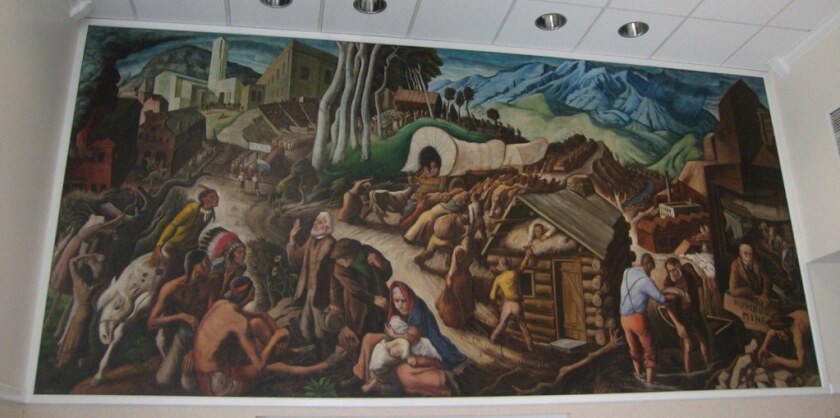How two Western artists competed for a commission in an unsuspecting place: the Provo Post Office.
At first glance, the former Provo post office seems like an unlikely place for an artistic rivalry. The mural gracing the top wall depicts a pioneer-era Provo alongside a 1920s Provo. But the contrast of the two eras isn’t the surprising part of the painting: it’s the fact that local Utah artist Everett Thorpe beat out premier artist of the American West Maynard Dixon for the commission.
![Round Dance Site[35].jpeg](https://brightspotcdn.byu.edu/dims4/default/6d2ddb8/2147483647/strip/true/crop/717x563+0+0/resize/717x563!/quality/90/?url=https%3A%2F%2Fbrigham-young-brightspot-us-east-2.s3.us-east-2.amazonaws.com%2Faa%2F22%2Ff119aa25464eb686b6cd5108bd46%2Fround-dance-site35.jpeg)
Dixon romanticized the wonder of Western American with his vibrant paintings of canyons, cowboys, and Native Americans. His paintings brought an escape to the 1920s world struggling with the Great Depression. In contrast, Thorpe was a virtually unknown artist, never making it outside of his Utah hometown.
The local Utahn somehow beat out a renowned American artist, and Associate Professor James Swensen (History of Photography) wondered why. He presented his findings at the March 23 lecture titled, “Not by the Hand of God: Maynard Dixon, Everett Thorpe, and the Mural Contest for the Provo Post Office.” Their artistic and thematic choices provide surprising context into why jurors commissioned Thorpe over Dixon, seeking Thorpe’s nuanced perspective rather than Dixon’s idealized view.
Maynard Dixon
Dixon had a long history of completing murals for the Department of the Interior. His desire to create Provo’s post office mural was a last hurrah to the old, remote, adventurous wild West depicted in popular media at the time. Dixon wanted a mural unlike stereotypical Western scenes of desolate rocks and native lifestyles—he wanted personality, a new subject matter, and the presence of the divine.
Dixon found his subject matter in an underrepresented group: the Mormons. Swensen argued that Dixon “anticipated that his proposal mural for the Provo Post Office could explore other Western populations he believed under duress.” Dixon noticed that small Mormon towns and their lifestyles were slowly dying, making them a fascinating subject for Dixon to paint.

The first proposal Dixon offered was an oil sketch of a group of Mormon settlers pursuing manifest destiny, calling it The Hand of God. The bearded man on the right likely represents Brigham Young or another elder within the Church. “Either way, the leader is shown with one hand on the tail [of the plow] and the other holding the law, thereby bringing together the two defining principles of LDS manifest destiny: God and the word preceded the plow,” Swensen added.
The large clouds above the settlers hint at the Divine and blessings to the faithful. While working on the painting, Dixon noted that because the post office was a federal building, he had to soft peddle religious elements through the piece, even though he wanted to be more imaginative because the subject matter was “supernatural."
Everett Thorpe
Thorpe took a different approach than Dixon, choosing to depict Provo through the years from pioneer times to the Depression era. Early and Modern Provo depicts the town in a nuanced light with the good and the bad.

The complicated nature of the mural with multiple storylines throughout makes Thorpe’s painting a surprising choice to win. Swensen primarily discussed the group of pioneers negotiating with Native Americans in the left foreground of the painting. According to reports, Timpanogos tribes made Mormon leader Dimick Huntington raise his hand and swear by the sun that they would not take their favorite hunting grounds or deprive them of their rights. Next to this event, a young mother holds her children tightly, worried and fearful about the Natives and process of colonization. “Together, these differences present a newer and stark portrayal of local histories that focus less on the myths of westward expansion and the supernatural and more on its realities,” Swensen said.
The Decision
Three local jurors decided the mural contest winner. Not swayed by Dixon’s reputation, the jurors thought that Dixon’s proposed mural lacked experimentation. They wanted a younger style of art but “heaven forbid cubist forms,” as one of the jurors said. Dixon’s art was not cubist, but it did lack the wild and swirly experimentation of Thorpe’s work.
Jurors were also concerned that Dixon’s age and health were rapidly declining, which also was a major factor in the panel’s decision. Ultimately, the panel commissioned Thorpe for the Provo post office mural.
Despite Thorpe’s seemingly large accomplishment, Dixon’s reputation has risen while Thorpe’s has “remained stagnant or worse” because his work never took off, according to Swensen. Dixon’s vision of the past promotes a more faith-filled and uplifting message of God than a reminder of positive and negative real-life events. The post office rivalry between Dixon and Thorpe leaves viewers wondering what we really remember from the past. Do we look to the idealized or realistic, or is there some in between?